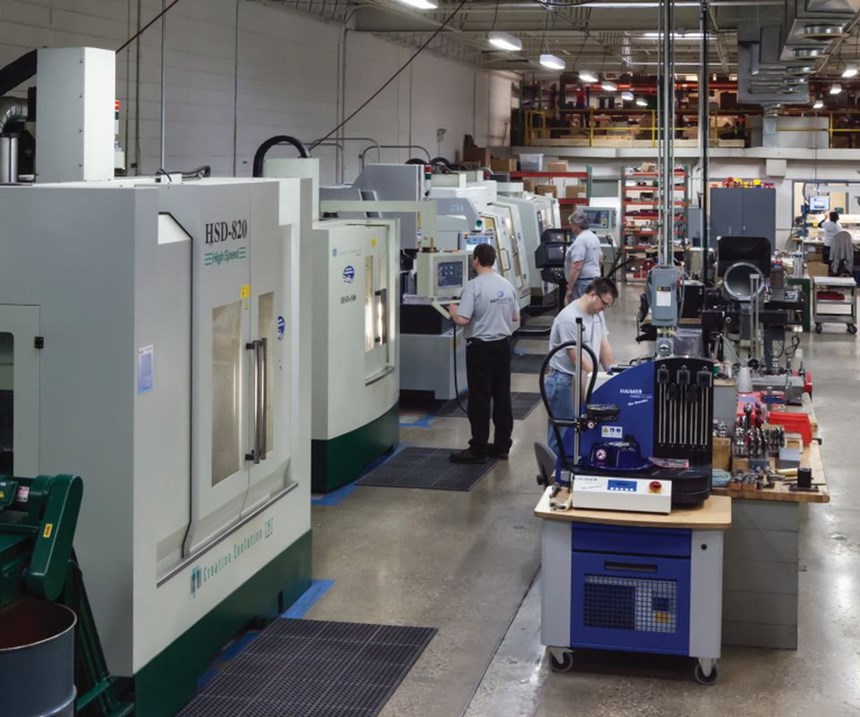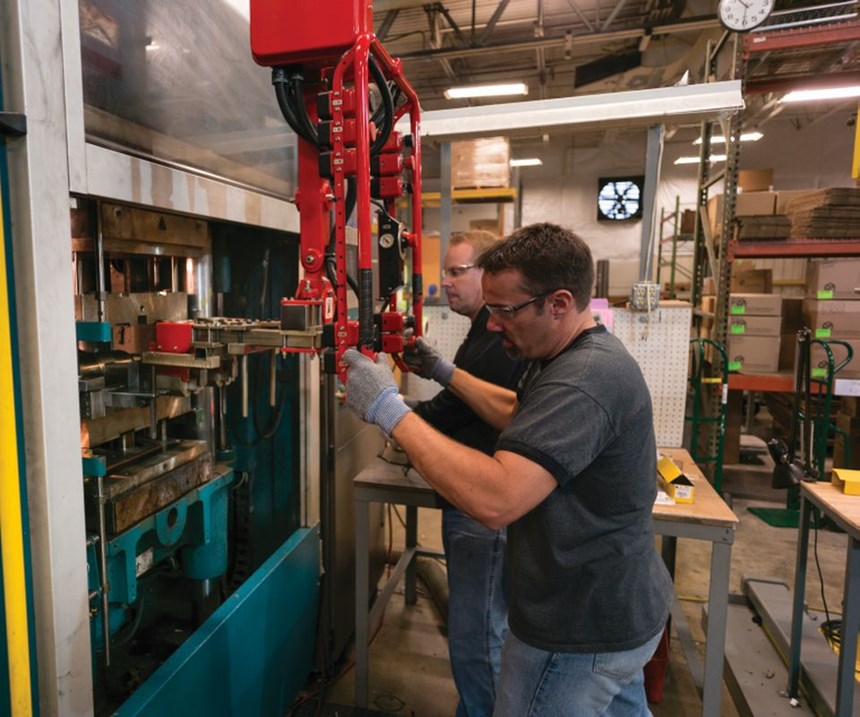Breaking Down the Skills Gap, Part 1
You can’t solve a problem without defining it first. This two-part series will help define the skills gap and offer solutions for closing it.
During a conference in late 2015 for technical college instructors, three manufacturers were asked to define and share their perspectives on the “skills gap.” Their responses varied widely. One presenter focused on the dearth of talent in one particular discipline, one discussed soft skills, and the third was unable to give a precise answer at all.
To help better define this skills gap, LAB Midwest of Mequon, Wisconsin, a technical education product and service provider, surveyed manufacturers across the United States for their perspectives. This study, conducted this past February with 78 industrial employers representing a wide range of company sizes and end markets, concluded that manufacturers are seeking but having a hard time finding a combination of manufacturing-specific aptitudes and soft personal skills in their new hires.
Featured Content
In terms of manufacturing-specific aptitude, participants in the study identified the ability to understand and follow work instructions; industrial engineering skills; and capacity for understanding manufacturing throughput, productivity, efficiency and lean manufacturing at the absolute top of the list. This was followed by capabilities in CNC programing and operation, automation and robotics, industrial equipment operation, and welding. When it comes to soft skills, manufacturers seek dependable team players who remain drug-free and are safety conscious, respectful, hard-working, productive and punctual.
According to the survey, the positions that manufacturers find most difficult to fill are manufacturing engineers, followed by CNC programmers. Industrial maintenance technicians, automation technicians, electricians and welders are also positions in high demand.
Based on these responses, the skills gap can be defined as the deficiency in the labor market of individuals possessing a combination of hard manufacturing skills and soft skills, resulting in a shortage of capable, skilled talent required by manufacturers to sustain and grow their businesses.
This shortage has, and will continue to have, a wide-ranging and potentially detrimental economic impact, not only on manufacturing, but on the U.S. as a whole. The National Association of Manufacturers (NAM) estimates that over the next decade nearly 3.5 million manufacturing jobs will likely be needed, and 2 million are expected to go unfilled due to the skills gap. The manufacturing sector plays a key role in providing family-sustaining compensation and maintaining quality of life, as manufacturers employ nearly 9 percent of the U.S. workforce in jobs that provide higher-than-average wages, and are much more likely to offer health insurance and other benefits. Manufacturers are also responsible for more than 75 percent of all the private-sector research and development performed in the U.S., providing a technological edge that is critical to continuing innovation and national security. The resulting impact of the skills gap will be far-reaching.
Mike Walter, president of Met2Plastic, a custom plastic processer in Elk Grove Village, Illinois, that specializes in injection molding and mold building for mission-critical industries including aerospace, medical and industrial equipment, says his company has experienced this shortage of skilled workers felt by manufacturers across the U.S.
“Back in the day, you could put an ad in the paper saying you needed a moldmaker or a process technician, you would have several people apply, and off you went.” Walter says. That ease of filling skilled manufacturing positions is now a distant memory. “The pool of skilled people is an ever-shrinking one. Like everyone else in our industry, we have a hard time filling skilled positions for molding and mold building. The skills gap can limit growth, because you can’t flex quickly and it makes it more difficult to adapt to the changing needs of customers,” he says.
Digging Deeper
Given the skilled-labor deficiency in an economy where supply is assumed to meet demand, one might expect young people would begin to realize that significant career opportunities exist in the industrial and manufacturing sectors, and would then increasingly select manufacturing as a career choice. This is not the case, however. In fact, in a 2014 study conducted by The Manufacturing Institute and Deloitte, more than 1,000 members of Generation Y (roughly 19- to 33-year-olds) ranked “manufacturing” dead last on a list of industries they would prefer to work in if they were beginning their careers today.
Emphasizing that point, when a group of about 60 high school seniors in Wisconsin’s Fox River Valley was asked during the school’s career day to offer their perceptions of manufacturing careers, the feedback included “sweaty,” “dirty,” “long hours,” “dead-end,” “no room for advancement,” “strikes,” “layoffs,” “hot” and “unsafe.” If these words are what come to mind when young people consider careers in manufacturing, is it any wonder that industrial employers are struggling to recruit them?
Mike Katz, president of Port Washington, Wisconsin’s Molded Dimensions Inc., a custom molder of rubber and polyurethane components, believes that manufacturers and their propensity to downsize as a first resort when business slows bear some responsibility for the problem.
“I’ve been in manufacturing since 1989 and worked in eight different facilities. One thing each of these was really good at was laying people off and, thanks to our access to instant information such as customer-demand cycles and future order data, laying them off quickly,” he says. “I’m not saying we should never shed five people so the other 80 can eat, but we need to keep in mind the impact that layoffs have on the perceptions of those considering careers in manufacturing.”
In addition to doing their part to ensure that jobs in manufacturing are stable and secure, manufacturers must play a role in familiarizing those outside the industrial community with the manufacturing environment of today. The Manufacturing Institute/Deloitte study also concluded that those who exhibited a higher level of manufacturing-industry familiarity ranked manufacturing third on the list of industry preferences, behind only technology and health care. The resulting conclusion is that, while manufacturing suffers a public relations problem among young people, its popularity grows considerably once those young people become familiar with potential manufacturing careers.
Many people have concluded that, in order to get young people interested in careers in manufacturing, their parents, guidance counselors, teachers, coaches and others influencing career decisions must be educated about financial and other benefits of choosing manufacturing as a career. However, while these individuals certainly have an impact on career decisions, a 2015 survey of more than 23,000 high school students and teachers by Skills USA, the Educational Research Center of America and The Manufacturing Institute indicates that there is one other factor that has a far more significant impact on a student’s career path.
More than any other single factor—three times more than any other—a student’s own interests and experiences have the greatest impact on his or her future career pathway. So, in order to fill the skills gap, it is necessary for young people to be exposed to manufacturing career options while their potential career preferences are forming. Are manufacturers doing their part?
During an industrial trade show for OEMs and contract manufacturers in Orlando, Florida, in February 2016, a 200-member audience was asked how many had attended their local high school’s career day, invited a group of high school students to tour their facility or mentored a high school student regarding manufacturing as a career choice. Fewer than five attendees could answer yes to any of these three questions.
On top of that, gone are the days when a student may have gained an interest in manufacturing through industrial arts or shop classes. In recent decades, technical education programs in many communities have been decimated due to budget cuts, standards-focused educational initiatives and a preference for four-year-college preparation, which does little to expose students to manufacturing technology. As a result, most students now graduate high school having no idea what a toolmaker, moldmaker, CNC operator, industrial maintenance technician, automation technician or welder does, much less recognizing the potentially rewarding career that might await a student who chooses such a pathway.
The Next Move
All of this does paint an unsettling picture for those manufacturers facing the skills gap as more and more baby boomers reach retirement age and leave the workforce. Industrial employers will find it increasingly difficult to secure the requisite talent to grow their organizations and compete in the global economy.
However, there still exists reason for optimism. Today, there are grassroots efforts led by industrial employers, educators and solutions providers who are partnering in innovative ways to educate young people about the rewarding careers that await them in the manufacturing sector, while exposing them to the environments and skills that nurture an interest in industry. In part two of this series, we will explore these efforts.
RELATED CONTENT
-
Making Quick and Easy Kaizen Work for Your Shop
Within each person is unlimited creative potential to improve shop operations.
-
How to Learn Mold Design Virtually
Plastics Engineering program instructors share their strategies for successful virtual learning for hands-on injection mold design.
-
Identifying and Examining Training Constraints
Finding, Training & Retaining Employees, Part 13

















